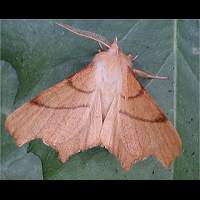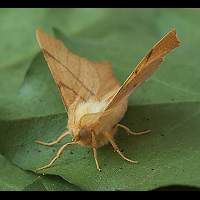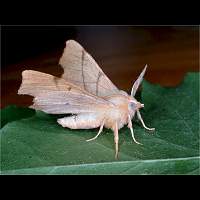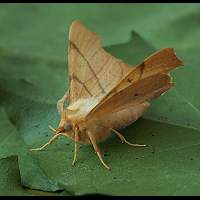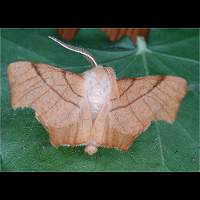September Thorn (Ennomos erosaria)
The September Thorn is yet another yellowish Thorn. The groundcolour varies from pale yellow to light brown. Even though some specimens are slightly dusted at times, the moth usually is unpatterned. The two lines on the wing run straight without angles. They tend towards eachother at the lower edge of the wings. There is no spot in the middle of the wings and there are no dark patches near the tip of the wings. The September Thorn is similar to the August Thorn, but the latter has the outer line clearly angled and is bigger, but less robust. September Thorns on the wing in July and the beginning of August are usually smaller and paler. The wingspan varies from 38 to 42mm.
The eggs are being laid in autumn on twigs of the foodplant. The eggs overwinter and hatch in May next year. The caterpillars behave in the typical way of Geometer Moths. They feed during the night. Daytime is spent sitting motionless like twig in the food plants. By the end of July a large spinning between leaves is made in which pupation takes place. Some moths do appear after some three to four weeks, but the majority appears by the end of August or in September. The caterpillars are very similar to twigs, including buds. The basic colour is brownish grey or grey, sometimes greenish grey. The head is either grey or brown. The brown, bud like swellings are found on the sides of segments 2, 5 and 6 and on top of segments 5, 8 and 11. The caterpillars are rather thin and long, reaching a length of 40 to 42mm. Foodplants include oak, birch, beech and lime.
The September Thorn has one brood a year and is on the wing from the end of June to mid-October. Moths flying about in June, July and the beginning of August are smaller and paler than specimens on the wing later. They fly by night only, but are attracted to light. And that is a good thing, for they are hardly ever seen otherwise. Animals caught during the night are easily photographed during the day. They may even be manipulated without taking off. The September Thorn is a species found in light forests, preferably on sandy soil. It is a common species in Wales and southern and Central England. Less common in northern England and southern Scotland. Very rare in Ireland. Quite common on the continent too, but usually a rather local species.
The September Thorn is yet another yellowish Thorn. The groundcolour varies from pale yellow to light brown. Even though some specimens are slightly dusted at times, the moth usually is unpatterned. The two lines on the wing run straight without angles. They tend towards eachother at the lower edge of the wings. There is no spot in the middle of the wings and there are no dark patches near the tip of the wings. The September Thorn is similar to the August Thorn, but the latter has the outer line clearly angled and is bigger, but less robust. September Thorns on the wing in July and the beginning of August are usually smaller and paler. The wingspan varies from 38 to 42mm.
The eggs are being laid in autumn on twigs of the foodplant. The eggs overwinter and hatch in May next year. The caterpillars behave in the typical way of Geometer Moths. They feed during the night. Daytime is spent sitting motionless like twig in the food plants. By the end of July a large spinning between leaves is made in which pupation takes place. Some moths do appear after some three to four weeks, but the majority appears by the end of August or in September. The caterpillars are very similar to twigs, including buds. The basic colour is brownish grey or grey, sometimes greenish grey. The head is either grey or brown. The brown, bud like swellings are found on the sides of segments 2, 5 and 6 and on top of segments 5, 8 and 11. The caterpillars are rather thin and long, reaching a length of 40 to 42mm. Foodplants include oak, birch, beech and lime.
The September Thorn has one brood a year and is on the wing from the end of June to mid-October. Moths flying about in June, July and the beginning of August are smaller and paler than specimens on the wing later. They fly by night only, but are attracted to light. And that is a good thing, for they are hardly ever seen otherwise. Animals caught during the night are easily photographed during the day. They may even be manipulated without taking off. The September Thorn is a species found in light forests, preferably on sandy soil. It is a common species in Wales and southern and Central England. Less common in northern England and southern Scotland. Very rare in Ireland. Quite common on the continent too, but usually a rather local species.

